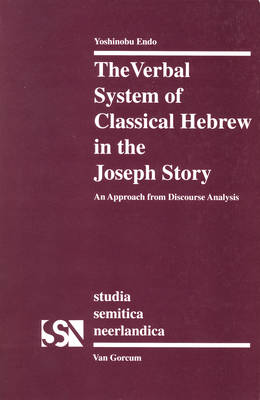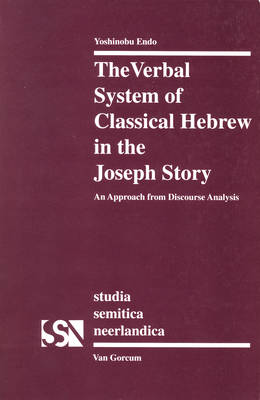
Je cadeautjes zeker op tijd in huis hebben voor de feestdagen? Kom langs in onze winkels en vind het perfecte geschenk!
- Afhalen na 1 uur in een winkel met voorraad
- Gratis thuislevering in België vanaf € 30
- Ruim aanbod met 7 miljoen producten
Je cadeautjes zeker op tijd in huis hebben voor de feestdagen? Kom langs in onze winkels en vind het perfecte geschenk!
- Afhalen na 1 uur in een winkel met voorraad
- Gratis thuislevering in België vanaf € 30
- Ruim aanbod met 7 miljoen producten
Zoeken
The Verbal System of Classical Hebrew in the Joseph Story
An Approach Form Discourse Analysis
Yoshinobu Endo
€ 305,45
+ 610 punten
Omschrijving
The present study investigates the function of the verbal forms in biblical Hebrew narrative, using the Joseph story (Gen. 37-50) as a corpus. It demonstrates how the 'tense', 'aspect' and 'sequentiality' function as factors in the choice of the verbal forms in both main clauses and subordinate clauses.
The tense distinction past vs. non-past basically works as a factor in the choice of the freestanding conjugations, except for the stative verb, the verb with a stative sense, the passive construction, or the performative utterance. Moreover, the traditional aspectual opposition complete vs. incomplete also corresponds to QATAL (*qátal) vs. YIQTOL (*yaqtúlu). There appears to be not much difference between these oppositions in describing the function of the above verbal forms (esp. ch.2).
Furthermore, the opposition non-sequential vs. sequential discriminates functionally between YIQTOL and (w, ) QATAL (*qatál) in the non-past context, between QATAL and (waY)YIQTOL (*yáqtul) in the past context, and between the IMPV (coh., impv. and juss.) forms and (w, ) QATAL (*qatál) in the hortatory context. In each context the former functions as a non-sequential form and the latter as a sequential form.
The phenomenon of sequentiality is purely syntactical. It controls the flow of the story as a discourse function; the non-sequential form stops the flow (i.e. stand still), while the sequential form lets the story flow on.
A thread of discourse is usually traced by sequential forms, but it may include non-sequential forms to signal the difference of discourse level or a discourse boundary. Or each form could play an opposite role to produce special literary effects (chs. 3-7).
Finally, a verbal form in the subordinate clause is chosen not from the viewpoint of the deictic centre of the narrator, but from that of the immediate participant in the main clause (ch. 8).
The tense distinction past vs. non-past basically works as a factor in the choice of the freestanding conjugations, except for the stative verb, the verb with a stative sense, the passive construction, or the performative utterance. Moreover, the traditional aspectual opposition complete vs. incomplete also corresponds to QATAL (*qátal) vs. YIQTOL (*yaqtúlu). There appears to be not much difference between these oppositions in describing the function of the above verbal forms (esp. ch.2).
Furthermore, the opposition non-sequential vs. sequential discriminates functionally between YIQTOL and (w, ) QATAL (*qatál) in the non-past context, between QATAL and (waY)YIQTOL (*yáqtul) in the past context, and between the IMPV (coh., impv. and juss.) forms and (w, ) QATAL (*qatál) in the hortatory context. In each context the former functions as a non-sequential form and the latter as a sequential form.
The phenomenon of sequentiality is purely syntactical. It controls the flow of the story as a discourse function; the non-sequential form stops the flow (i.e. stand still), while the sequential form lets the story flow on.
A thread of discourse is usually traced by sequential forms, but it may include non-sequential forms to signal the difference of discourse level or a discourse boundary. Or each form could play an opposite role to produce special literary effects (chs. 3-7).
Finally, a verbal form in the subordinate clause is chosen not from the viewpoint of the deictic centre of the narrator, but from that of the immediate participant in the main clause (ch. 8).
Specificaties
Betrokkenen
- Auteur(s):
- Uitgeverij:
Inhoud
- Aantal bladzijden:
- 368
- Taal:
- Engels
- Reeks:
- Reeksnummer:
- nr. 32
Eigenschappen
- Productcode (EAN):
- 9789023230939
- Verschijningsdatum:
- 1/01/1996
- Uitvoering:
- Paperback
- Formaat:
- Trade paperback (VS)
- Gewicht:
- 645 g

Alleen bij Standaard Boekhandel
+ 610 punten op je klantenkaart van Standaard Boekhandel
Beoordelingen
We publiceren alleen reviews die voldoen aan de voorwaarden voor reviews. Bekijk onze voorwaarden voor reviews.









